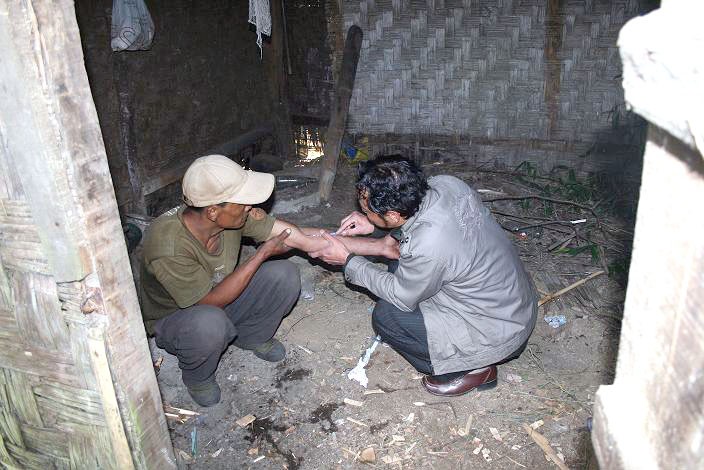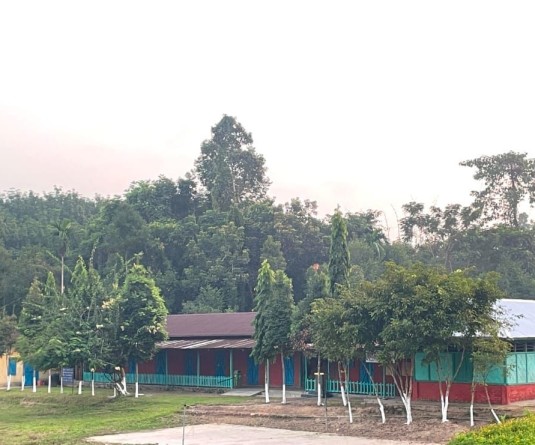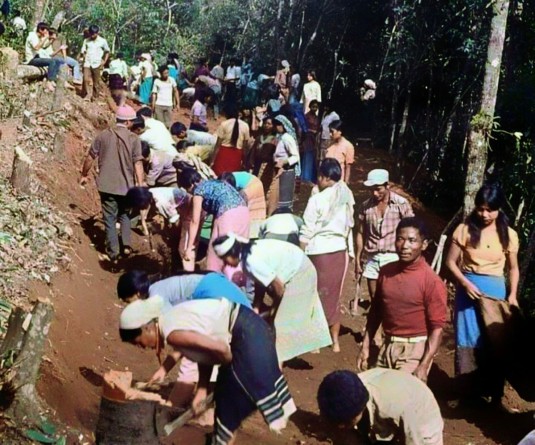One of the ‘hotspots’ (a term used for places where IDUs converge to have their daily shots) identified by RWA in Pfütsero. IDUs are sensitized on the consequences of sharing needles by peer educators, while gradually encouraged to give up drugs.

Imkong Walling
Morung Express News
A quaint little place atop the hills, Pfütsero is like any other small town in Nagaland – serene and scenic. Beneath the calm and the quiet, this town of hardly 40000 people, overlooking the majestic Mount Saramati is now riding high on the successful implementation of an ‘injecting drug use’ intervention progamme under Project Orchid supported by the Avahan initiative of the Bill and Melinda Gates Foundation.
Spearheading the movement against drug abuse, though with a humane touch, is Rukizumi Welfare Society (RWS) Pfütsero, who are advocating a substitution therapy for victims of drug abuse. Called Oral Substitution Therapy (also known as OST), it involves substituting the regular illicit drugs like heroin and spasmoproxyvon with a prescribed replacement medicine. Simply put, it means that people or victims of drug abuse, registered under the programme, are administered a daily dose of Buprenorphine (under medical supervision), thus eventually ridding them off their earlier dependence on illicit psychotropic substances.
“Substitution treatment is the most effective option for heroin dependence treatment related to HIV transmission and the care of drug users with AIDS,” states the World Health Organisation. Buprenorphine is a WHO prescribed drug and is included in the organisation’s ‘Essential Medicines List’. Not only does it keep at bay withdrawal symptoms, it also allows the clients to engage in productive activities whilst under the programme. It is estimated that at present only 8 percent of IDUs have access to OST worldwide; whilst, in India it is accessible to only 3 percent of IDUs.
According to statewide figures released by Centre for Advocacy and Research (CFAR), 1395 IDUs have been enrolled so far under OST in Nagaland; out of which 316 have successfully completed the therapy. By successful completion, it means 0% report of injecting or drug use at the time of discharge. Further, it has not only reduced intravenous administration of psychotropic drugs and sharing of syringes, a decrease in unsafe sexual practices and increased condom use has been observed, stated the report. Other significant developments have been in employment, reemployment and greater financial stability as a result of reduced spending on drugs.
For a town, as small as Pfütsero in area and population, the menacing effect of drug abuse on a sizeable number of hidden populace of IDUs was at its peak, before the current intervention programme happened. RWS is now operating in 27 villages and three towns in Phek district – reaching out to estimated 1200-plus IDUs. Formed in 2000, it started implementing the IDU Targeted Intervention project in October of 2004.
The OST was introduced in 2006 with a target of reaching out to 80 IDUs for a start. It now has 72 IDUs under OST while registering 118. It has to its credit 18 IDUs to have successfully completed the therapy, while 23 dropped out and 2 referred to rehab. According to RWS, there are about 20 female IDUs, who were reluctant to come forward for help. Outreach workers now go to them. Social stigma remains high for women IDUs which prevents them to come out in the open.
Recently, a team of media persons from the mainland as well as the state was taken on a site visit to Pfütsero to have a hands-on experience of the project ongoing, courtesy CFAR. Supported by Avahan - the India AIDS initiative, CFAR is an advocacy and communication research organisation working to improve understanding of HIV & AIDS and the response shaped; led by the vulnerable communities in partnership with state governments, NGOs and the community.
There goes a saying ‘Seeing is believing’. Indeed, the visit was an awakening for the media team, interacting with the outreach workers and the OST clients in particular. And the work of RWS awe-inspiring. The beginning was however not that easy facing much opposition from the church and the civil society. “When we initiated the project in 2004, the Church and women’s group leaders felt we were encouraging drug use by ‘distributing’ needles and syringes and condoms. They visited us or we were called by them to discontinue the intervention,” says project Director of RWS, Vetsyuri.
Today, the same people who opposed the project are endorsing RWS and their work. It was the result of their unyielding effort to take the church into confidence and the civil society. Over the last five years, project volunteers have visited every church in the town and its surrounding areas, interacting with the pastors and other church leaders.
“We met with the Chakhesang Baptist Church initially, to inform of them of our work. Initially they were not convinced, but agreed not to oppose the services. We then visited each church and told them of the harm reduction approach. In 2008 at the annual conference of the Chakahesang Baptist Church, the women department made a resolution to participate and support in the prevention and awareness of HIV and AIDS. Once OST came, it became easier to speak to the church leaders,” adds Vetsyuri.
The success of the project is somewhat summed up by the pastor of Pfütsero Town Baptist Church, Rev. N. Chiero. His comments in the record of project workers states, “When RWS started working we were sceptical. They met us, spoke to us about their work, we listened quietly. But after the programme started petty crimes and deaths reduced and we began to take interest in their work. They are doing good work, we support them. The church has also introduced HIV & AIDS as a part of the syllabus at the Baptist Theological College in Pfütsero. When the students pass out will be better equipped to deal with issues like drug use and HIV & AIDS.”
Twenty-six years old, Ato, is currently under OST. Married with a 14-month old daughter, by profession, he is a carpenter and an electrician, while also working as a peer educator at RWS drop-in centre in Pfütsero. “I started to spend a lot of money buying my daily dose as well alcohol and always worried about the next dose and never think of working. My family rejected me and stopped talking to me. My relationship with my wife declined,” says Ato, who took to drugs about 11 years back.
Now, under OST, he testifies that there has been a big change in his life, albeit, for the better. He says that his physical health has improved and importantly, regaining his mental composure injecting in him the desire to lead a normal working life. He hopes to eventually come out of OST even stronger.
There are many like Ato, whose lives have been turned around. They have banded together to form a support group. Christened ‘Espor’, meaning hope, it was established in 2008 by the clients of RWS.
Starting with 28 members, the group is now 64 members strong. Some of the members are currently under OST, while most are clean. The main objective of ‘Espor’ is to ‘support one another towards better knowledge, awareness about drug use and HIV & AIDS, train & orient one another, practical support in accessing services etc’. The network plays a crucial role in intervening as and when a crisis arises. “Once we were leading a hopeless life, disowned… but with the effort of RWS and ESPOR we are able to reach out” says Joseph, president of Espor.






